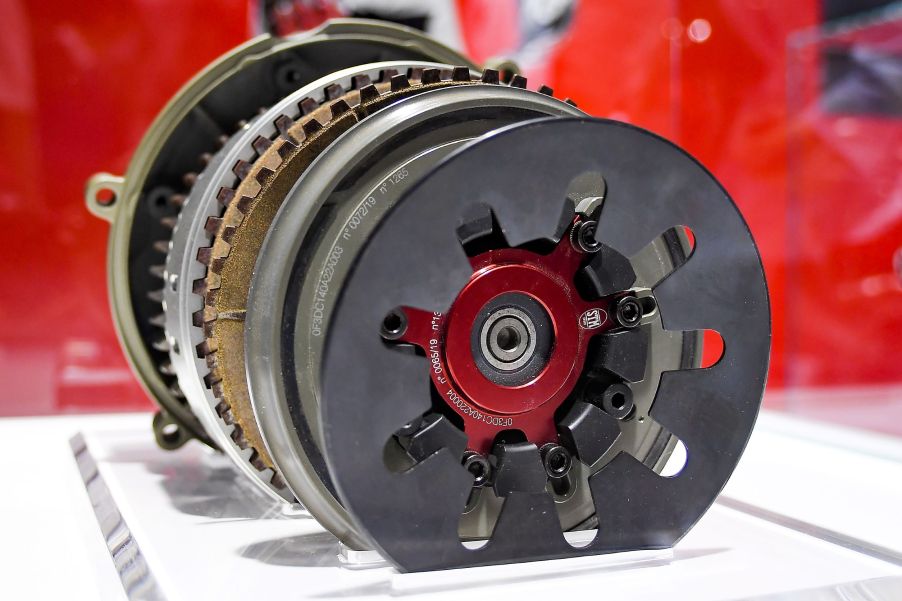
Do Ducati Motorcycles Still Come With Dry Clutches?
Ducati prides itself on evolving through racing, but like any other manufacturer, it knows the power of tradition. So, although modern motorcycle manufacturing has made desmodromic valves unnecessary, Ducati still uses them. You know, for old time’s sake. But there’s something else that Ducati is also known for—dry clutches. At least, it used to be synonymous with them. However, does any modern Ducati motorcycle still rock the dry clutch?
What makes a dry clutch different from wet motorcycle clutches?

Although manual car and motorcycle transmissions are arranged differently, they have a few basic parts in common. Both have input and output shafts, for example, as well as gears and clutches. And both motorcycle and car clutches feature discs (plates) of high-friction material connected to pressure plates and springs.
Usually, car clutches have just one large-diameter friction disc and pressure plate. And that used to be the case with motorcycles back in the day, Motorcyclist says. But apart from one hold-out, most modern motorcycle clutches have multiple, smaller-diameter friction plates sandwiched between identically-sized steel plates. That way, the clutch—or ‘clutch pack,’ as it’s sometimes called—is more compact. And because stacking these plates multiplies their load capacity, riders can easily work the clutch cables of even high-performance bikes.
But there’s one more key difference between car and motorcycle clutches beside their plate arrangements. While the clutch, engine, and transmission are connected mechanically in a car, they’re still separate parts. And while the transmission has fluids and the engine has oil for cooling and lubrication, the clutch touches neither.
In most motorcycles, though, the engine, transmission, and clutch pack bathe in the same engine oil supply. This is the ‘wet clutch’ arrangement, and it explains why bike oil isn’t interchangeable with car oil. However, some bikes mimic cars and physically separate their clutch packs from the joined engine and transmission. Because they’re not soaked in oil, they’re called ‘dry clutches.’
Why did Ducati put dry clutches in its road motorcycles?
Although Ducati is practically synonymous with dry clutch motorcycles, it’s not the only OEM that uses them. Some classic BMW bikes have them, for example, Motorcyclist notes. Plus, remember that bit about the clutch pack hold-out? It’s Moto Guzzi. Even the latest versions of the V7, V9, and V85TT have single-plate dry clutches.
In addition, every MotoGP race bike features a dry clutch pack. And Ducati uses them for similar reasons.
Wet clutches have several crucial advantages over dry clutches in everyday riding situations. Because they’re covered in engine oil, they stay cool, which means they last longer and can tolerate more abuse in, say, stop-and-go traffic. Wet clutches also usually have wider friction zones, another benefit in slow traffic, Motorcyclist says. And they’re quieter, too, though as we’ll explain shortly, that might be a downside for some Ducatisti.
For all their benefits, wet motorcycle clutches have some drawbacks. They technically introduce dust into the engine oil, but unless your oil filter is old, it’s a non-issue. Working with wet clutches can get messy fast if you’re not careful, though. Also, and this is crucial for racing, the oil saps some engine performance.
That’s the main reason why dry clutches were ubiquitous on Ducati motorcycles: no parasitic drag, Motorcyclist explains. True, cleaner oil and fewer maintenance messes are minor bonuses. But because Ducati built its image on racing successes and overall performance, it needed every edge it could get. So, it ditched the oil and went ahead with dry clutches, leading to the iconic ‘nuts-and-bolts’ rattle that many associate with vintage Ducatis.
Which Ducati models have these clutches today?

That beloved rattle, though, also highlighted some of the dry clutch’s flaws. Because these clutch packs lack cooling oil, they heat up and wear out noticeably faster. They’re also grabbier and harder to modulate, Motorcyclist notes. And while some Ducati owners install open clutch covers to deal with the heat—and show off their clutches—this exacerbates the noise issue.
But the noise isn’t just annoying to some—depending on where you live, it might be illegal. And while racetracks don’t have emissions regulations, they do have decibel limits, Motorcyclist adds. So, to avoid breaking any laws, Ducati has mostly switched over to wet clutches these days.
Yet it still puts dry clutch packs in some of its most extreme road-going motorcycles (and its MotoGP bike). The Ducati Panigale V4 R and SP, for example, have dry clutches, while the V2, V4, and V4 S have wet ones. It’s a similar story with the Streetfighter V4 SP. However, the Italian company offers $3240 dry clutch conversion kits for the Panigale and Streetfighter V4, as well as the Multistrada V4.
In short, yes, some Ducati motorcycles still use dry clutches. But apart from the sound factor, the main benefits come on the racetrack, not the street.
Follow more updates from MotorBiscuit on our Facebook page.


